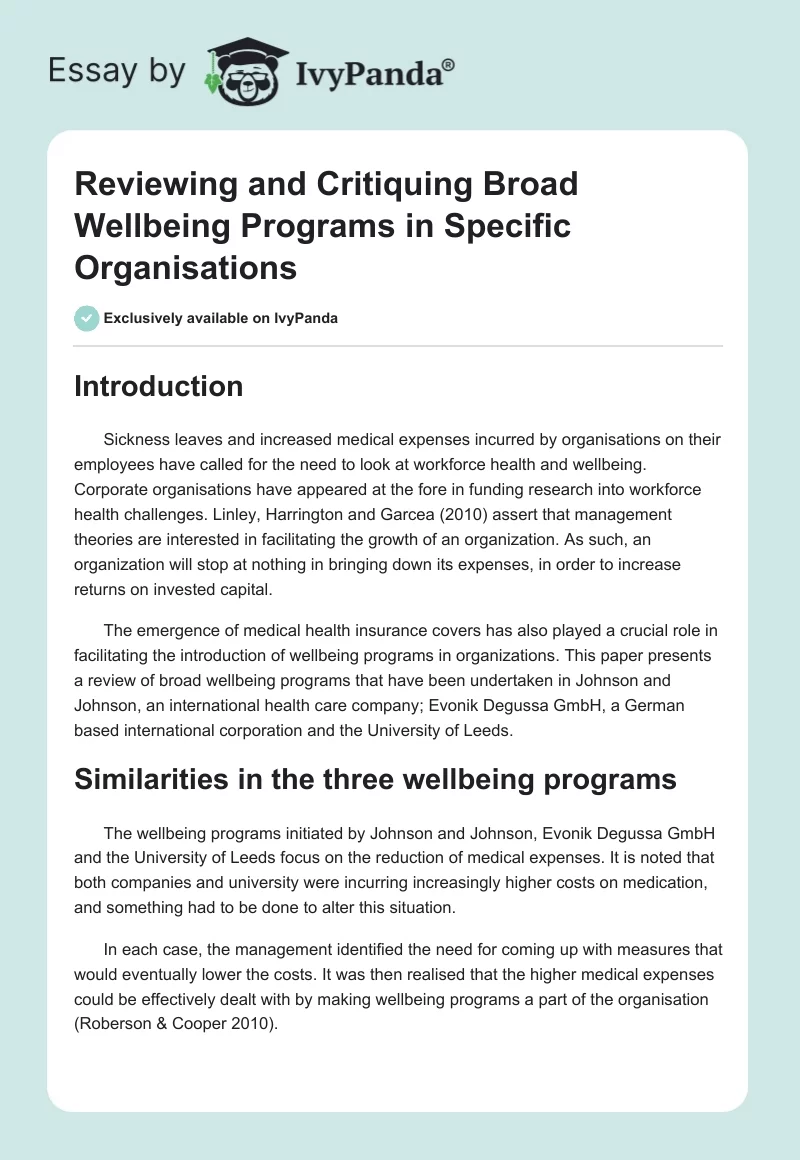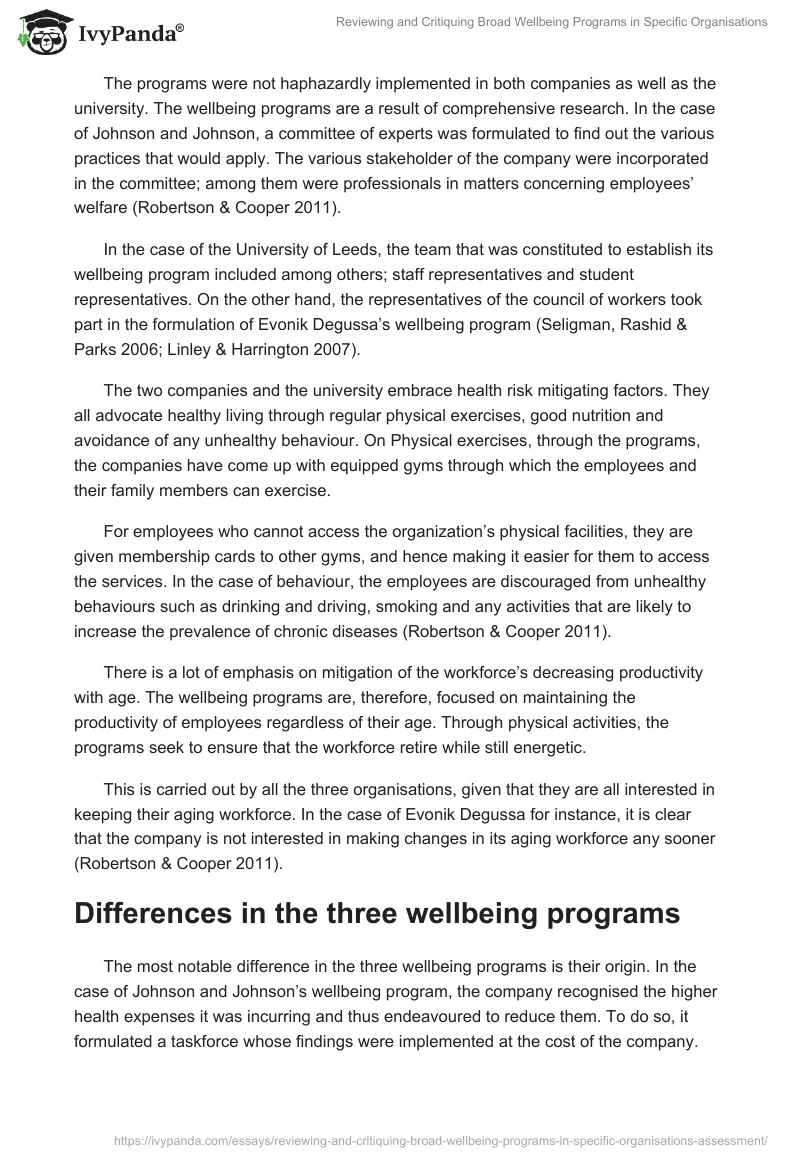Introduction
Sickness leaves and increased medical expenses incurred by organisations on their employees have called for the need to look at workforce health and wellbeing. Corporate organisations have appeared at the fore in funding research into workforce health challenges. Linley, Harrington and Garcea (2010) assert that management theories are interested in facilitating the growth of an organization. As such, an organization will stop at nothing in bringing down its expenses, in order to increase returns on invested capital.
The emergence of medical health insurance covers has also played a crucial role in facilitating the introduction of wellbeing programs in organizations. This paper presents a review of broad wellbeing programs that have been undertaken in Johnson and Johnson, an international health care company; Evonik Degussa GmbH, a German based international corporation and the University of Leeds.
Similarities in the three wellbeing programs
The wellbeing programs initiated by Johnson and Johnson, Evonik Degussa GmbH and the University of Leeds focus on the reduction of medical expenses. It is noted that both companies and university were incurring increasingly higher costs on medication, and something had to be done to alter this situation.
In each case, the management identified the need for coming up with measures that would eventually lower the costs. It was then realised that the higher medical expenses could be effectively dealt with by making wellbeing programs a part of the organisation (Roberson & Cooper 2010).
The programs were not haphazardly implemented in both companies as well as the university. The wellbeing programs are a result of comprehensive research. In the case of Johnson and Johnson, a committee of experts was formulated to find out the various practices that would apply. The various stakeholder of the company were incorporated in the committee; among them were professionals in matters concerning employees’ welfare (Robertson & Cooper 2011).
In the case of the University of Leeds, the team that was constituted to establish its wellbeing program included among others; staff representatives and student representatives. On the other hand, the representatives of the council of workers took part in the formulation of Evonik Degussa’s wellbeing program (Seligman, Rashid & Parks 2006; Linley & Harrington 2007).
The two companies and the university embrace health risk mitigating factors. They all advocate healthy living through regular physical exercises, good nutrition and avoidance of any unhealthy behaviour. On Physical exercises, through the programs, the companies have come up with equipped gyms through which the employees and their family members can exercise.
For employees who cannot access the organization’s physical facilities, they are given membership cards to other gyms, and hence making it easier for them to access the services. In the case of behaviour, the employees are discouraged from unhealthy behaviours such as drinking and driving, smoking and any activities that are likely to increase the prevalence of chronic diseases (Robertson & Cooper 2011).
There is a lot of emphasis on mitigation of the workforce’s decreasing productivity with age. The wellbeing programs are, therefore, focused on maintaining the productivity of employees regardless of their age. Through physical activities, the programs seek to ensure that the workforce retire while still energetic.
This is carried out by all the three organisations, given that they are all interested in keeping their aging workforce. In the case of Evonik Degussa for instance, it is clear that the company is not interested in making changes in its aging workforce any sooner (Robertson & Cooper 2011).
Differences in the three wellbeing programs
The most notable difference in the three wellbeing programs is their origin. In the case of Johnson and Johnson’s wellbeing program, the company recognised the higher health expenses it was incurring and thus endeavoured to reduce them. To do so, it formulated a taskforce whose findings were implemented at the cost of the company.
This was in regard to the recommendation of the report, which clearly indicated the merits of such a program. On the other hand, Evonik Degussa’s wellbeing program is a product of Germany’s insurance policy. The policy requires that organizations institute wellbeing programs. The program in this case is fully sponsored externally, that is, the insurer takes care of all the financial requirements for the program (Dweck 2008).
The University of Leeds’s wellbeing program is unique from the other two. It contains volume on psychological health. The program underscores the importance of shifting wellbeing programs from matters of physical health to paying attention to matters of positive psychology.
It makes it clear that poor productivity in modern society has a lot to do with the stress associated with work when compared to that resulting from physical health. The program undertakes to address this issue by carrying out significant changes in its management structure. It puts a lot of emphasis on departure from the top-down management structure, which gives the executive the powers to make key decisions without consulting the people charged with their implementation (Robertson & Cooper 2011).
Comment on the statement
“Many workplace wellbeing programs have been too top down with little choice for employees, focussing mainly on reducing physical illness to save the company from health care costs, not seeking to promote psychological health and wellbeing- focussing on avoiding what’s wrong rather than approaching what is right”.
Organisation management theories are ever interested in teaching the practices that enhance profitability of an organization (Linley, Harrington & Garcea 2010). This has been the driving force behind the formation and implementation of the majority of workplace wellbeing programs (Linley & Harrington 2007, Todd 2006).
The organizations are always in fixing the drawbacks to their performance, and in so doing, they hardly consider doing the right thing. This has been the main hindrance of most of the organisations workplace well being programs (Bova & Kroth 2001; Peterson et al. 2009).
Bova and Kroth (2001) and McGregor (2006) denote the need to overlook the traditional leadership models in order to establish psychological health and wellbeing. The traditional leadership models, being too top down ensure that employees are not consulted in coming up with wellbeing programs whose mandate is enhancing their wellness. There is a need for positive psychology to be introduced in the management of an organisation.
They argue that the resulting changes are sufficient in setting a framework through which stress related under performance in an organisation can be taken care of (Mischel et al. 2002; Seligman et al. 2005). Organisations need to stay focused on improving the wellbeing of employees. Research clearly indicates that work related stress is a key factor in the low productivity of employees as they age.
At the same time, dealing with an aging workforce is soon going to be the order of the day. It is no longer business as usual, as Martin (2005) argues; organisations need to undertake measures to facilitate both physical and mental health of their employees. This will not only take care of the employees present health requirements, but will improve their overall health records. It has been revealed that the employers will have a healthy and productive workforce that will transcend its age (Tolbize 2008; Kupperschmidt 2000).
Conclusion
Investing in the health of employees is an important mission that organisations should undertake. Many organisations have, however, failed to understand the need to go beyond physical health when considering worker health programs. There is a need for investing in the workforce psychological health as well in order to enhance a holistic life.
References
Bova, B, & Kroth, M 2001, ‘Workplace learning and generation X’, Journal of Workplace Learning , Vol.13 no. 1, pp.57-65.
Dweck, C 2008, ‘Can personality be changed? The role of beliefs in personality and change’ Current Directions in Psychological Science, Vol.17, pp.391–394.
Kupperschmidt, BR 2000, ‘Multigenerational employees: Strategies for effective management’, The Health Care Manager, Vol.19 no. 1, 65–76.
Linley, PA and Harrington S 2007, ‘Playing to your strengths’, The Psychologist, Vol.19 no. 2, pp.85.
Linley, PA, Harrington, S and Garcea, N 2010, Oxford Handbook of Positive Psychology and Work, Oxford University Press, London.
Martin, C A 2005, ‘From high maintenance to high productivity’, What managers need to know about Generation Y”, Industrial and Commercial Training, vol. 37no. 3, pp.39-44.
McGregor, D 2006, The Human Side of Enterprise, McGraw-Hill, New York.
Mischel, W, Shoda, Y & Mendoza, DR 2002, ‘Situation-behavior profiles as a locus of consistency in personality’, Current Directions in Psychological Science, Vol. 11 no. 1, pp.50–54.
Peterson, C, Park, N, Hall, N and Seligman M 2009, ‘Zest and work’, Journal of Organizational Behavior, Vol. 30 no. 3, pp.161–172.
Robertson, I & Cooper, C 2010, Well-Being: Productivity and Happiness at Work, Palgrave Macmillan, New York.
Seligman, M, Rashid, T & Parks, AC 2006, ‘Positive Psychotherapy’, American Psychologist, Vol. 61 no. 5, pp.774–788.
Seligman, M, Steen, T, Park, N and Peterson C 2005, ‘Positive psychology progress: Empirical validation of interventions’. American Psychologist, Vol.60 no. 2, pp.410–421.
Todd, D 2006, ‘Multigenerational employees: Strategies for effective management’, The Health Care Manager, Vol.19 no. 2, pp.65–76.
Tolbize, A 2008, Generational Differences in the Workplace. Web.


